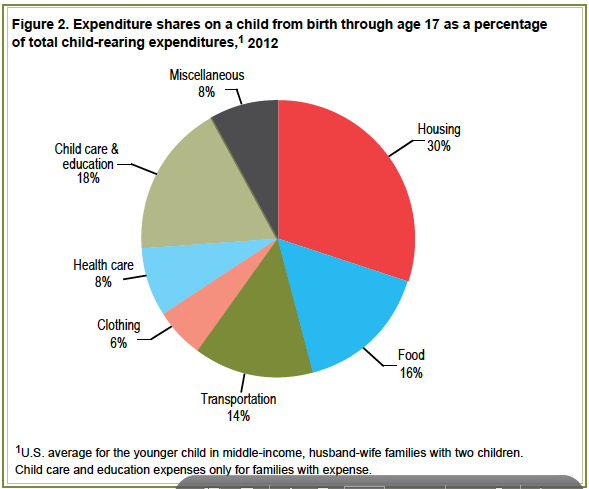
When Does it Cost Too Much to Save a Human Life?
May 25, 2014
The Income Inequality That Doesn't Bother Us
May 27, 2014Our Monday Gender Issues Focus
When people ask how much children cost, they expect to hear a dollar total. For women, though, the cost can be much more.
First, I did check the dollar total. According to the US Department of Agriculture, in 2012, covering child rearing expenses from birth to age 18, an average middle income family will spend $241,080. You can see though, that where you live makes a difference:
Predictably, housing is the most costly expense:
One paper that I discovered, though, focused on the cost of children from a woman’s perspective. In addition to spending on food and transportation and housing, women experience the cost through their career choices, wage sacrifices and less human capital investment.
Women in more abstract professions like technology, research and the law tend to have fewer children although they do want larger families. If these women interrupt their careers with a 12-month absence after having worked for 5 to 8 years, their wages decrease by 2%. More years mean approximately 2% less for each extra 12-month absence. And, the women who have worked for longer than 8 years sacrifice even more in lifetime income for each missed year. Correspondingly, women with children earn less than other women who are childless and their earnings trajectory is different. Having children means your earnings stop rising from age 27 to 38 while for the average male and childless female in a similarly abstract profession, they do not. Finally, human capital investment logically completes the picture. Having had parental leave and then perhaps opting for part-time, women with children have a lower rate of human capital growth.
Our bottom line? Women “pay for” the cost of children through their career choice, lower wages and less human capital growth.
Using statistics from Germany, the 2011 paper on which I based my discussion also considered the role of public policy. Here in the US, I wonder what government should do about the cost that women “pay” for children. Your suggestions? Please let us know in the comments.
![econlifelogotrademarkedwebsitelogo[1]](/wp-content/uploads/2024/05/econlifelogotrademarkedwebsitelogo1.png#100878)





